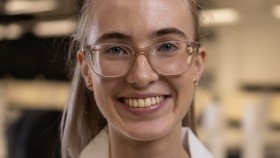Understanding the first galaxies represents a great contemporary challenge for astronomy.
Understanding the first galaxies represents a great contemporary challenge for astronomy. When the Universe cooled sufficiently that primordial hydrogen recombined, light was able to travel freely without scattering for the first time, forming the Cosmic Microwave Background which describes the state of the Universe 380,000 years after the Big Bang. Small ripples of density from this time grew under the influence of gravity, forming sites for the first galaxies that appeared after a few hundred million years, resulting in a large UV flux that reionised intergalactic hydrogen throughout the Universe. The time when galaxies first became dominant contributors to the thermal evolution of the Universe can be associated with this epoch when the combined galaxies in the Universe had produced enough ultra-violet light to reionise all of the hydrogen.
There are several key observational areas in which substantial progress is being made in the study of the first galaxies. These include ongoing programs with an emphasis on obtaining data beyond the current redshift frontier. Following the success of HST, JWST is revolutionising the discovery of high redshift galaxies thought to be responsible for reionisation. The advent of 30-meter class optical/IR telescopes in the next decade such as the GMT, will open a further window on the Universe allowing spectra to be taken of the earliest galaxies. At the same time the reionization of the IGM is being measured with increasing precision. High redshift quasars provide targets for studies of the IGM using quasar absorption spectroscopy to measure IGM properties through Ly-alpha absorption, while Planck has provided tight constraints on the integrated ionisation history of reionization.
Much emphasis is also now also being placed on experiments to measure the redshifted 21 cm radio signal from atomic hydrogen, which will provide a direct probe of the IGM in the high redshift Universe. Radio telescopes such as the Murchison Widefield Array in Western Australia are leading efforts in this exciting new field. Planned measurements include the evolution of the sky-averaged emission (so-called global signal), which will provide a powerful probe of the earliest stars and their thermal impact on the IGM, and the power-spectrum of intensity fluctuations which will measure the structure and evolution of the reionization process which is thought to be highly spatially in-homogenous .
The goal of these observations is to elucidate the history and origin of the first galaxies and their influence on the IGM, which must be understood within a physical framework. In this context theoretical models that include detailed physics of galaxy formation and intergalactic hydrogen therefore play a key role. Our science program in this area has been under-pined by development of the Meraxes semi-analytic galaxy formation and reionisation model (Mutch et al 2016; Qin et al 2018), which is utilized in combination with observational data to understand the evolution of the IGM during the Epoch of Reionisation. Studying the formation and evolution of galaxies together with the reionisation of cosmic hydrogen using semi-analytic models (such as Meraxes) requires N-body simulations within large volumes and high mass resolutions. We recently reached a milestone by computing the 21-cm global signal and power spectra during the Epoch of Reionisation using a simulation of side-length 300 Mpc with 43203 particles resolving dark matter haloes to masses of 5×108 h-1 Msolar (Balu et al. 2022; Figure 1). To reach the mass resolution of atomically cooled galaxies, thought to be the dominant population contributing to reionisation, at z = 20 of ∼ 2 × 107 h-1 Msolar, we augment this simulation using a Monte-Carlo merger tree algorithm (achieving an effective particle count of ∼ 1012). To our knowledge, this work represents the first model of both reionisation and galaxy formation which resolves low-mass atomically cooled galaxies while simultaneously sampling sufficiently large scales necessary for exploring the effects of X-rays in the early Universe.
Figure 1: The light cone evolution of the 21-cm brightness temperature from the IGM for a simulations 3000Mpc on a side from 30<z<5.
The statistics of 21cm radiation fluctuations from the reionizing IGM are known to be sensitive to the properties of the galaxy population that generates the ionizing radiation field. For example, more massive, biased galaxies produce larger, more highly clustered cosmic HII regions. Thus, the statistics of 21cm emission from reionization could be used to probe properties of the galaxy population that are otherwise not observable. Because the physics of galaxy formation and the large-scale radiative effects of reionization are present in the latest Meraxes simulation we can use it to explore what properties of galaxy formation at very high redshift can be studied by measuring the statistical fluctuations in 21cm using the SKA. Specifically, using the Fisher matrix formalism we explore the complex and degenerate high-dimensional parameter space describing the galaxy formation model and forecast quantitative constraints from a 1000 hr mock observation of 21-cm power spectrum (Balu et al. 2023). The model allows us to forecast constraints on the X-ray luminosity, ionising UV photon escape fraction, star formation and supernova feedback of the first galaxies. We demonstrate that it is possible to recover the parameters describing most of these properties to better than 10 per cent precision (Figure 2).
Figure 2: Forecast constraints on astrophysical model parameters assuming a 1000 hr mock observation with the SKA1-low. Dark (light) contours represent the 2-D marginalised confidence intervals and the diagonal subplots show the 1-D marginalised probability distribution functions.
Stuart Wyithe
















